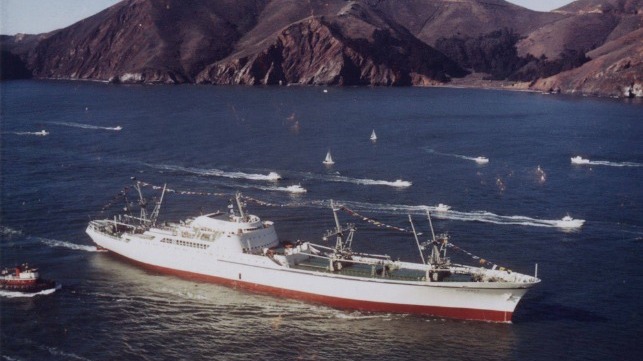MARAD Seeks Preservation Proposal as NS Savannah Completes Decommissioning

The decommissioning process for the n/s Savannah, the world’s first nuclear-powered merchant ship is well underway with the U.S. Maritime Administration recently jointly publishing a Notice of Availability and a Request for Information. MARAD reports that the dismantlement and removal of major systems, structures, and components that were part of the ship’s nuclear power plant is complete and they have set February 16, 2024, as the deadline as they seek to determine preservation interest from entities that may wish to acquire the ship.
The funds for decommissioning the historic ship were appropriated in 2017 and with the process nearing completion, MARAD reports that the vessel’s Nuclear Regulatory Commission (NRC) license will be terminated. They estimate that the vessel will be available for transfer to a qualified organization approximately three to six months after the NRC license is terminated.
The notice and request for proposals was published in the Federal record on October 30 and today, November 18, they are conducting the first briefing for organizations. Next month, MARAD will be making the vessel available for inspection by organizations in advance of the deadline for submitting proposals.
Launched in 1959, the n/s Savannah was designed as a demonstration ship and a signature element of President Dwight Einsenhower’s Atoms for Peace program. After World War II, there was growing interest in the potential of nuclear power with maritime propulsion seen as one promising area. The project to build a merchant ship however was in competition with the U.S. Navy that was trying to achieve its modern nuclear-powered fleet.
Despite the Navy’s opposition, the Savannah, which was named for a pioneering U.S. steamship that claimed the honors in 1819 crossing the Atlantic with steam power, was commissioned in 1962. She was designed to accommodate up to 60 passengers and 14,000 tons of breakbulk cargo. The first years of her career were spent as a demonstration ship with MARAD reporting she sailed 90,000 miles, visited 13 countries, and hosted 1.4 million visitors to show off the “marvel” of nuclear propulsion. Fears of the unknown, however, meant that the ship experienced protests and countries that denied her entry into their ports.
After carrying over 800 passengers during her demonstrations, she was converted in the second part of the 1960s to all cargo and began commercial operations. She was laid up in 1970 with MARAD reporting she had traveled over 450,000 nautical miles, on 163 pounds of uranium, before completing her original purpose as a demonstration ship. They began looking for a preservation solution for the ship, and she spent 13 years on display in Charleston, South Carolina. She was damaged by a hurricane and in need of long-term maintenance when she reverted to MARAD in 1994. She has spent most of the last 15 years in Baltimore with MARAD maintaining the ship while also pursuing the decommissioning.
After working with a broad range of organizations, a Programmatic Agreement for the decommissioning and disposition was executed in March 2023 which outlines the agreed process. MARAD submitted its License Termination Plan (LTP) to the NRC for its review and approval on October 23, 2023. While the license termination plan also has the option of scrapping the vessel or reefing it, MARAD is seeking viable preservation alternatives.
MARAD is asking organizations to provide a mission statement, their experience with historic properties and ship maintenance, as well as funding sources and their proposed location for the ship. At the same time, they report that they are exploring several different methods of conveyance which may or may not involve MARAD’s continued involvement. However, they expect to either retain title or a reversionary interest. MARAD says it is “choosing to defer its obligation to scrap n/s Savannah to some future date.” They expect to deliver the ship in as-is condition while noting that they have made improvements which may help to defray some of the initial starting costs for potential recipients who would preserve the ship.
The efforts at handing the historic ship over for preservation come as the industry is re-awakening to the potential of a new generation of nuclear-powered vessels. While navies around the world readily adopted nuclear technology, commercial shipping did not with only a few nuclear-powered ships ever being built. Only Russia has a commercial nuclear-powered ship but new technologies are being studied for future maritime applications.
